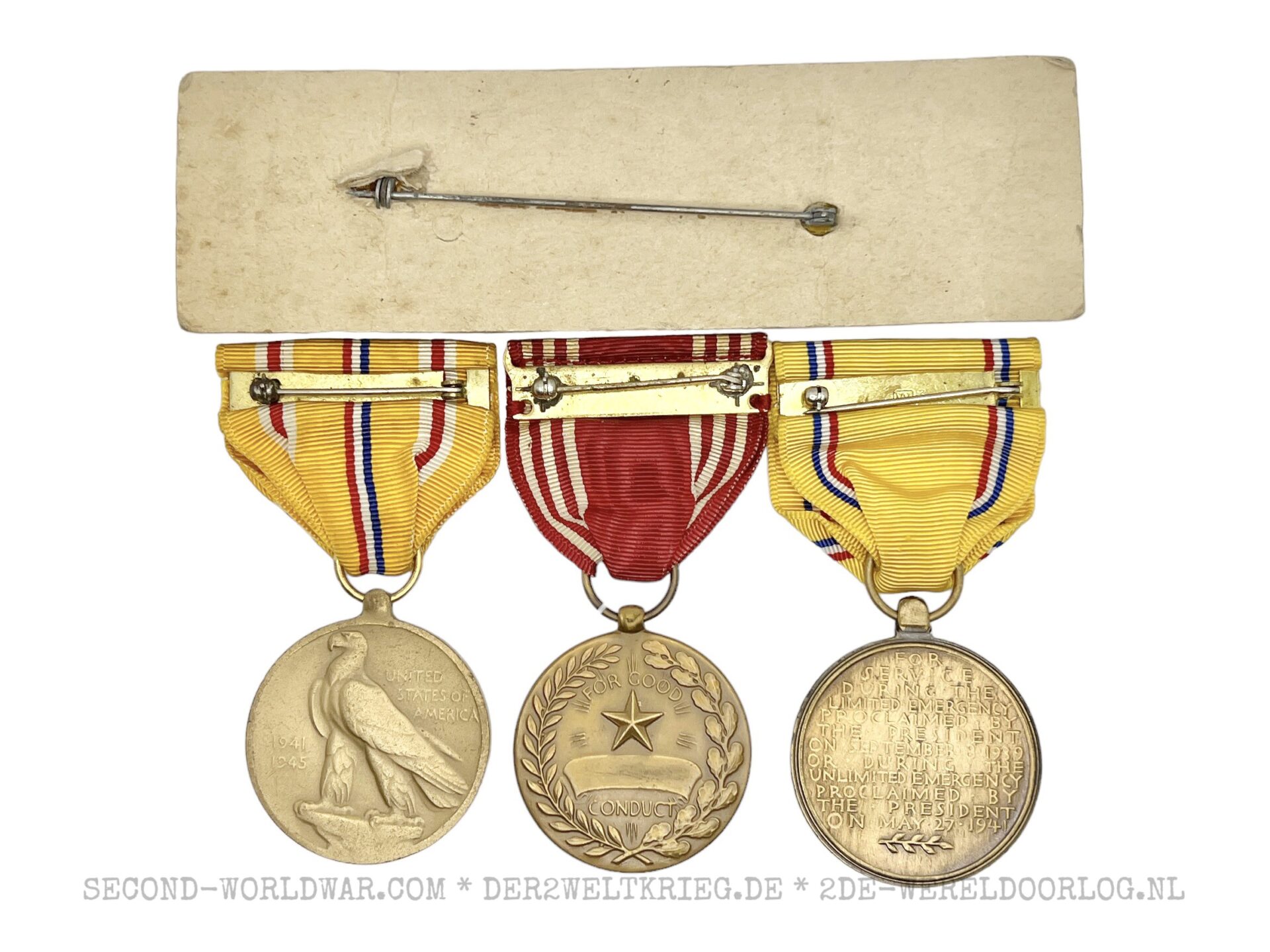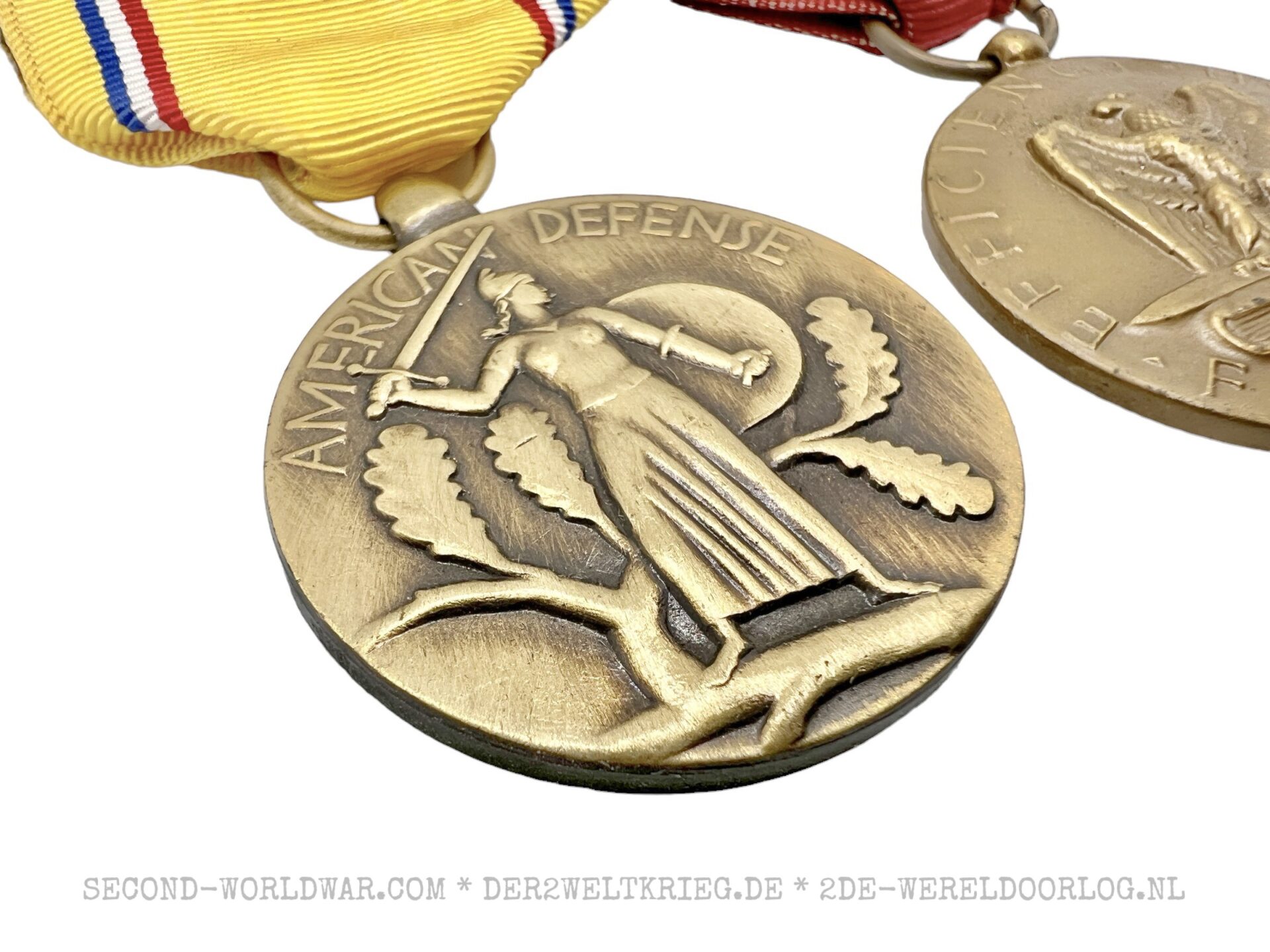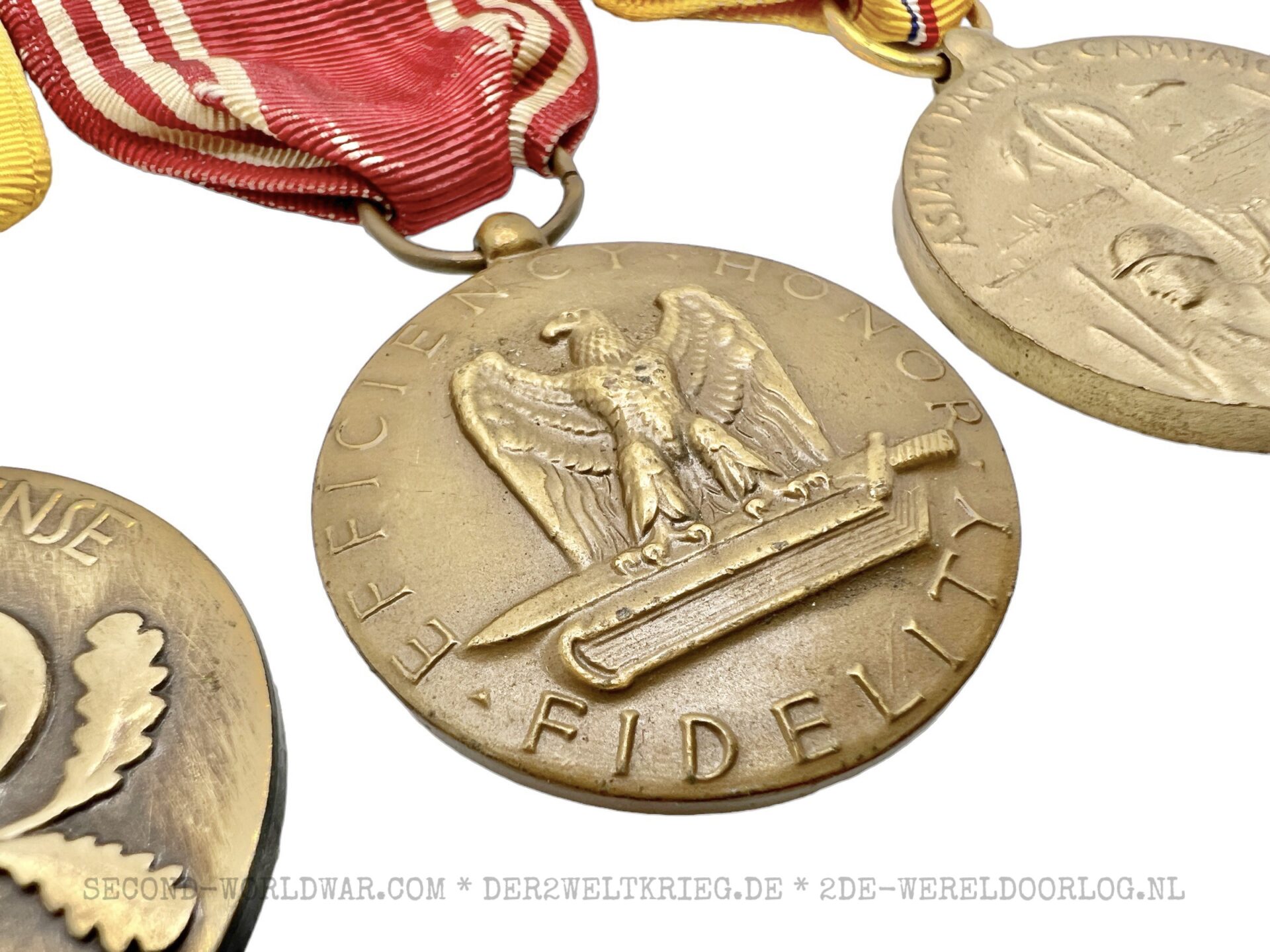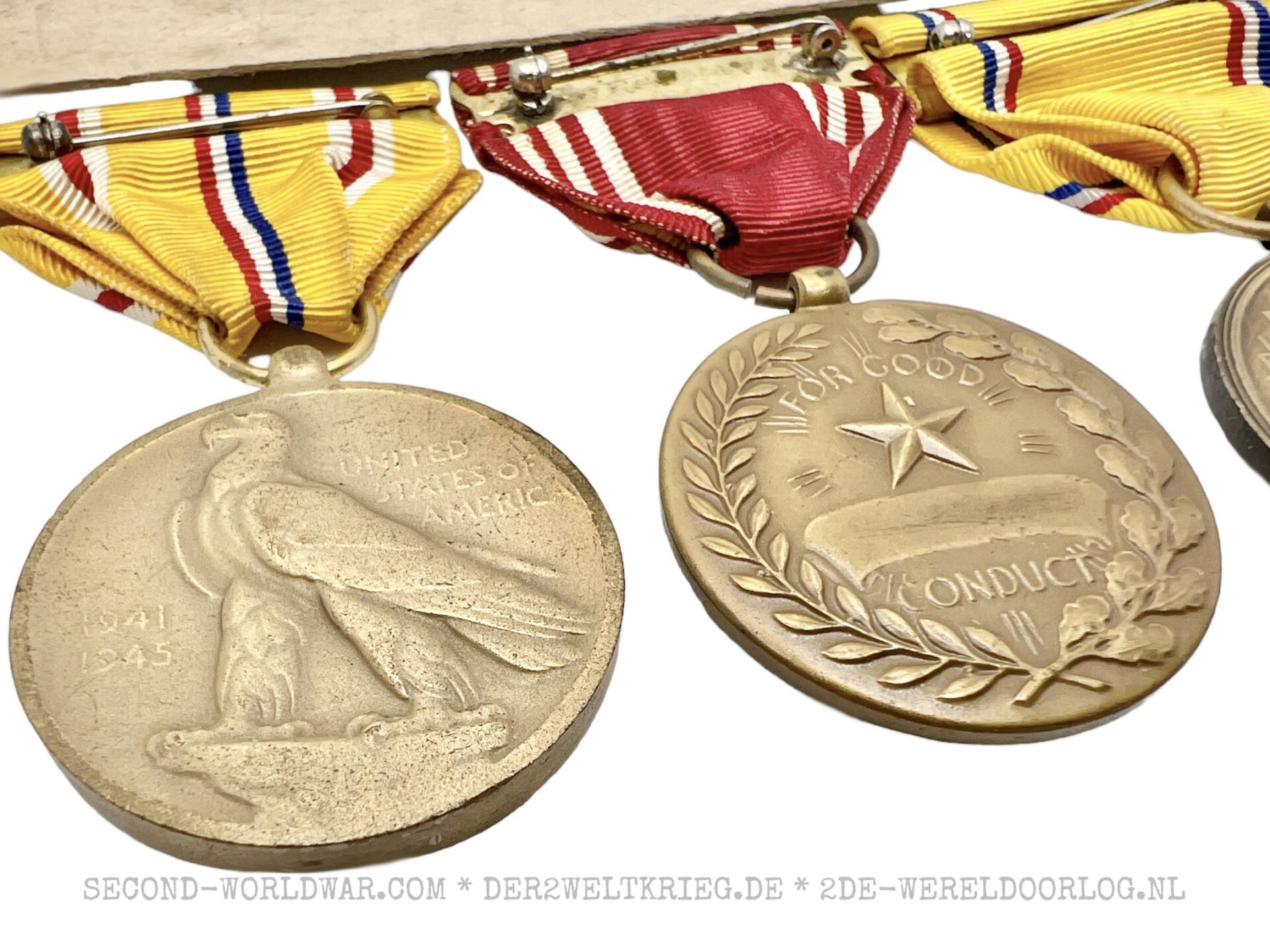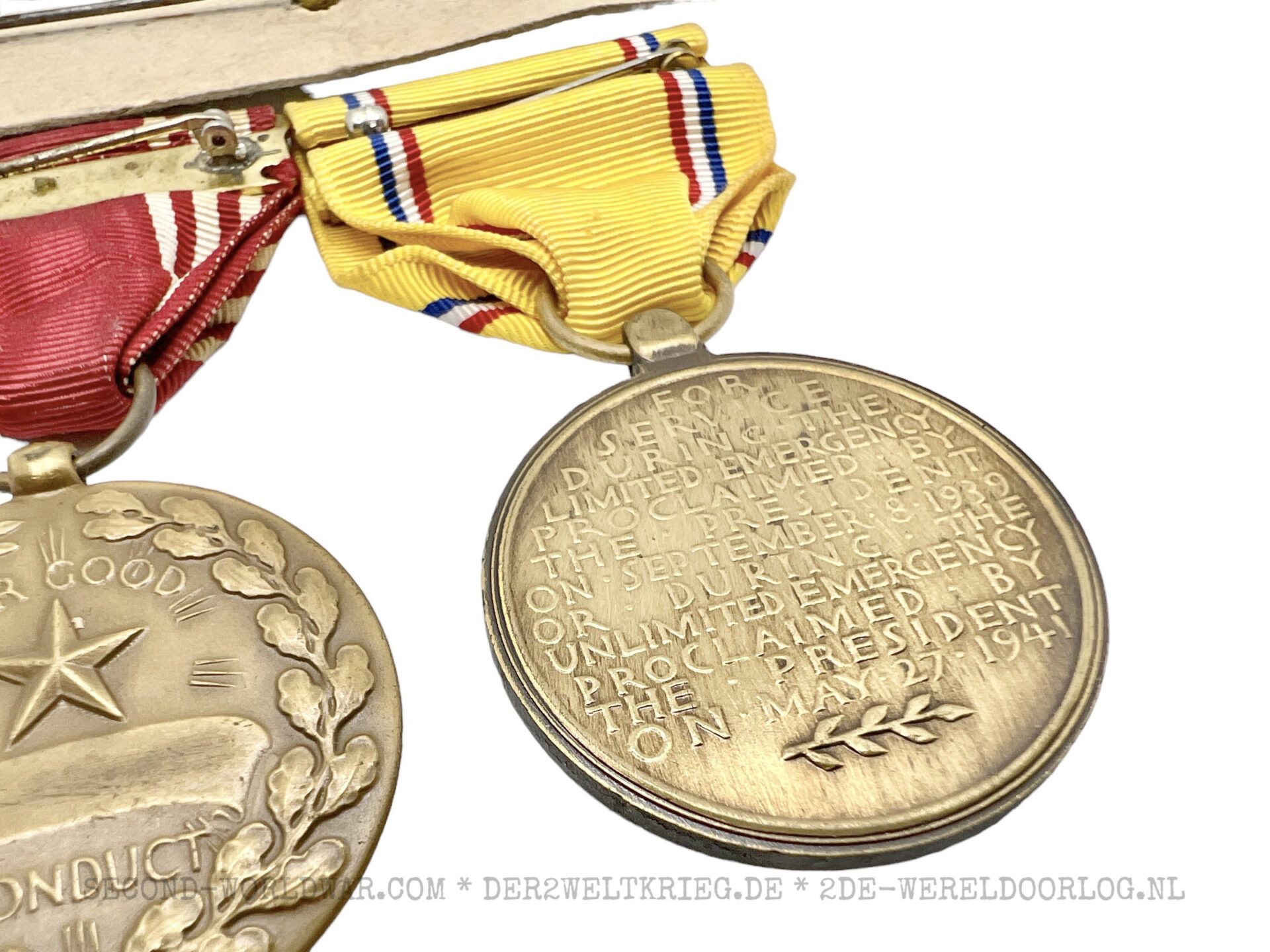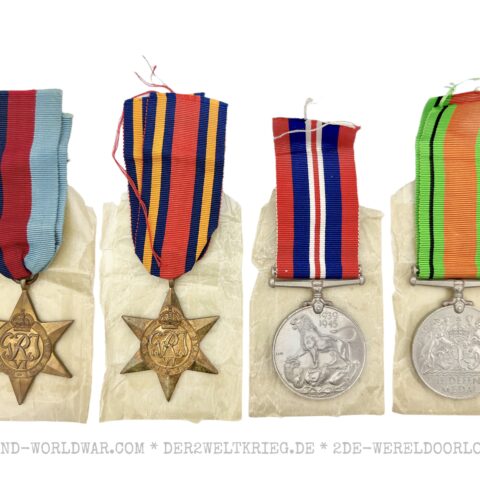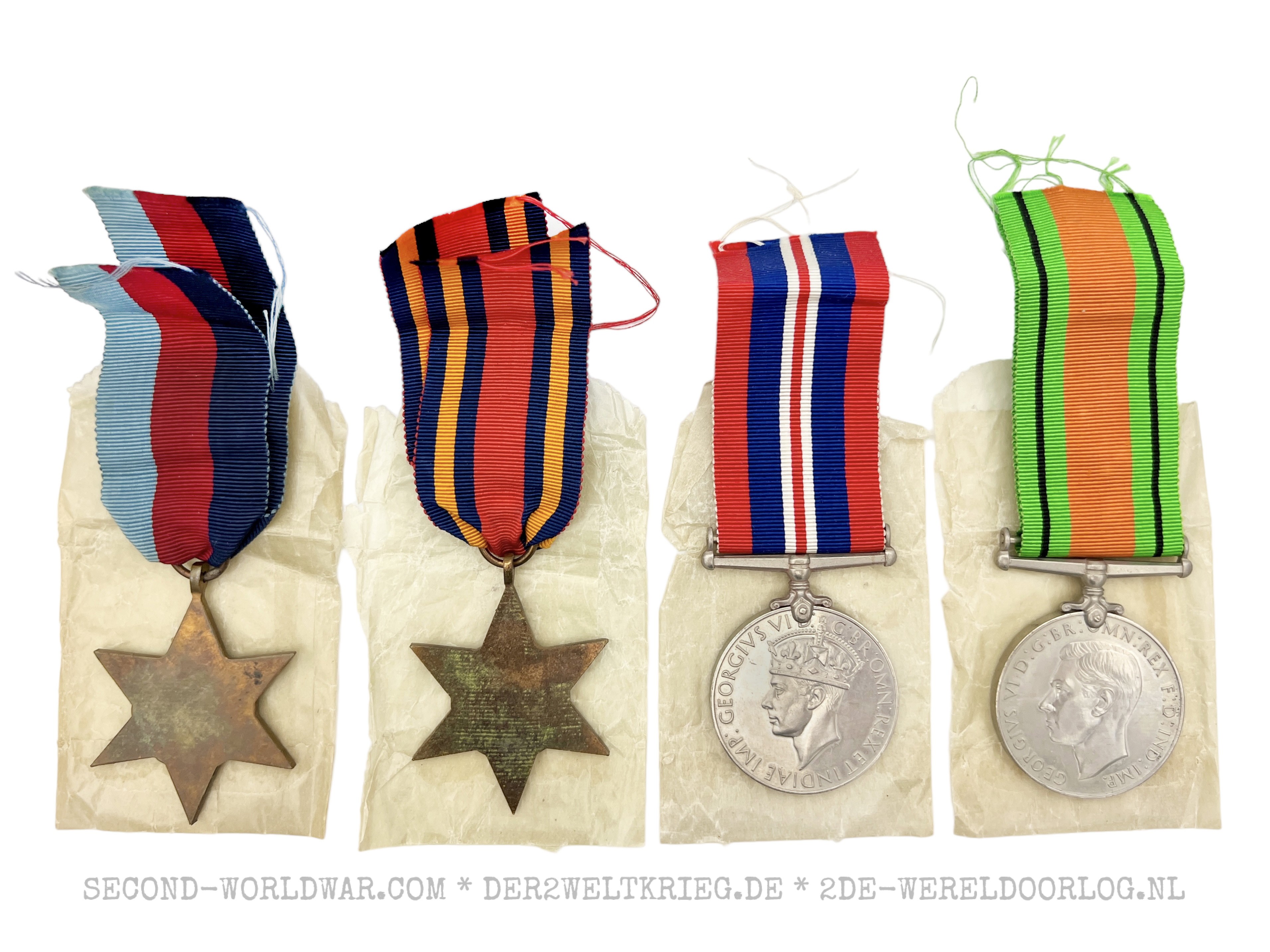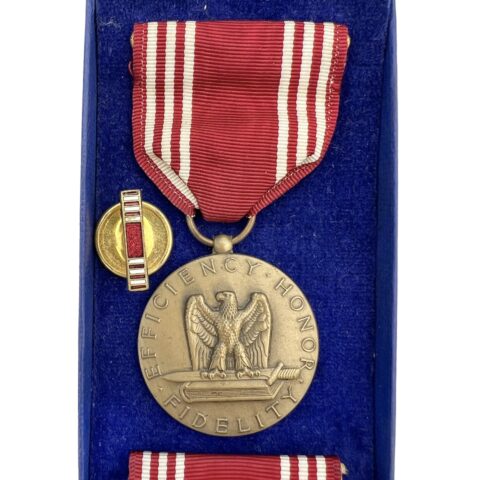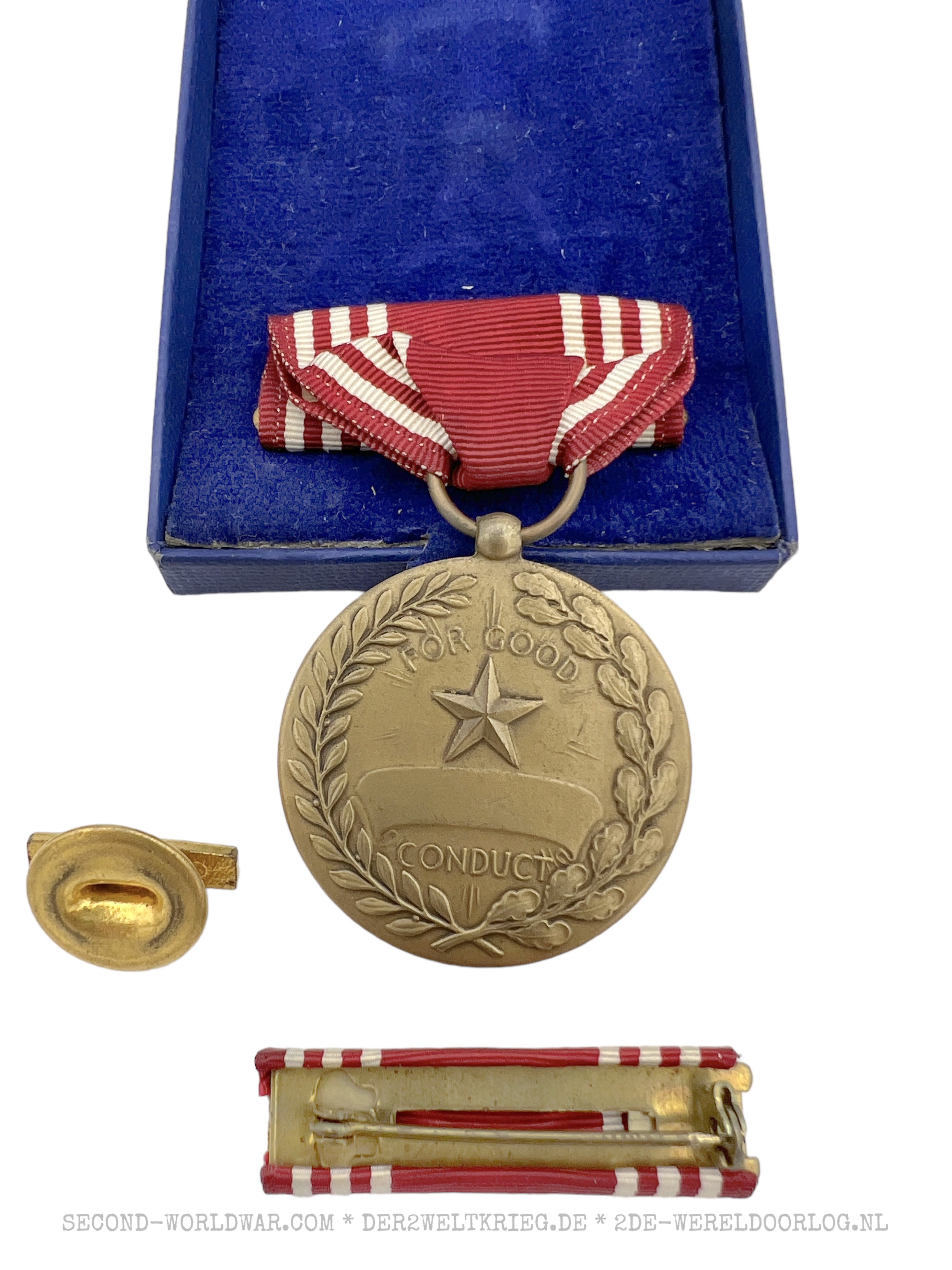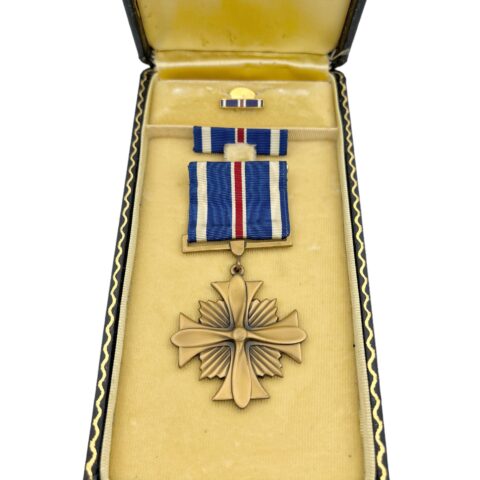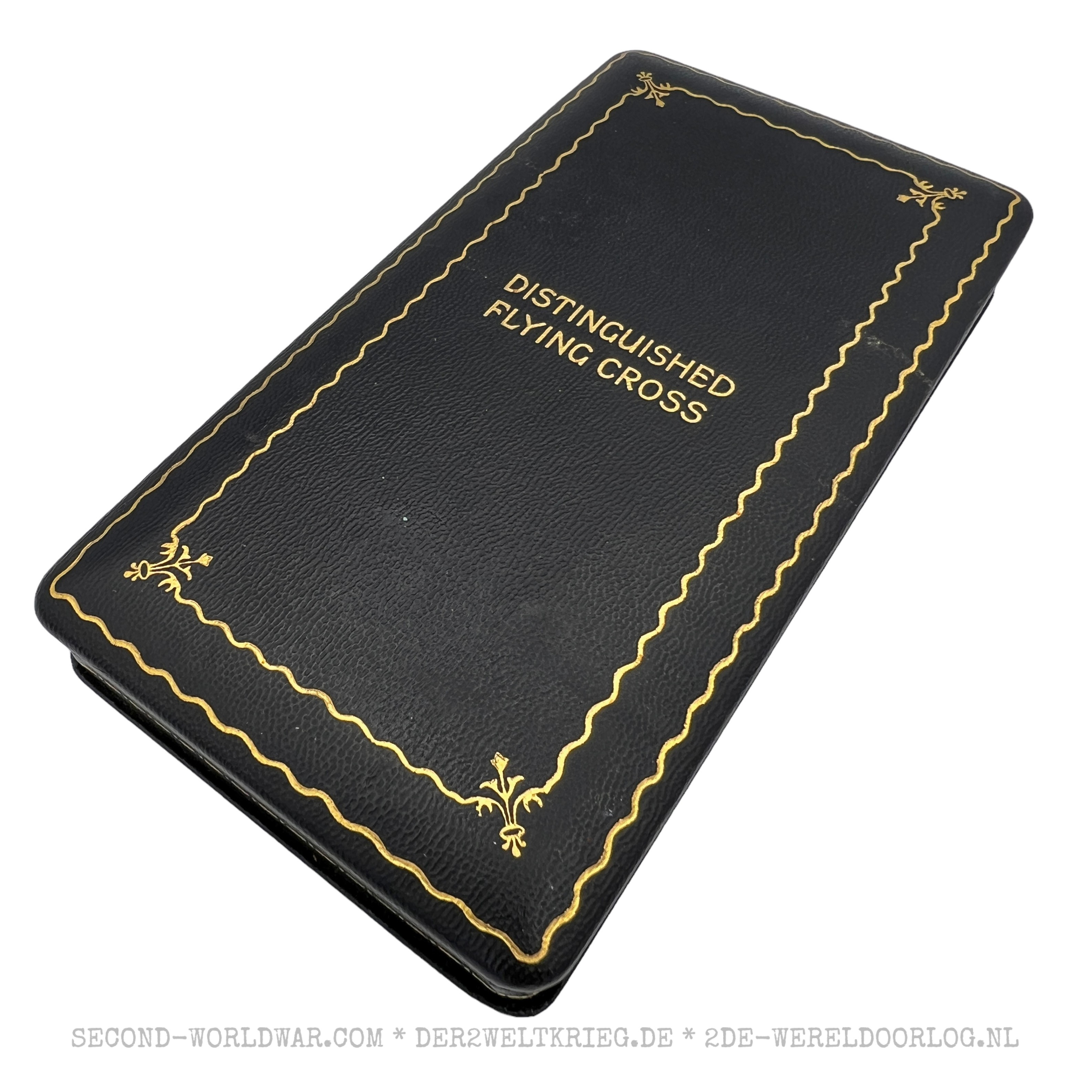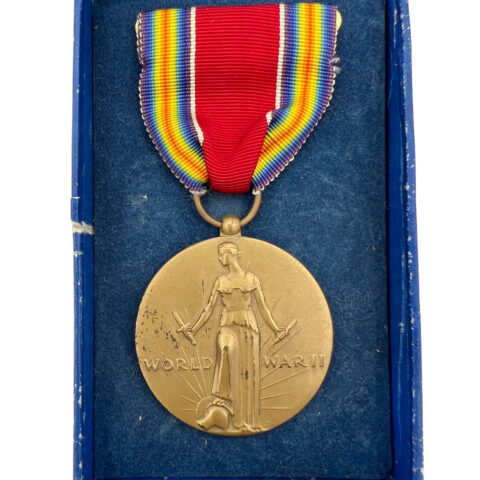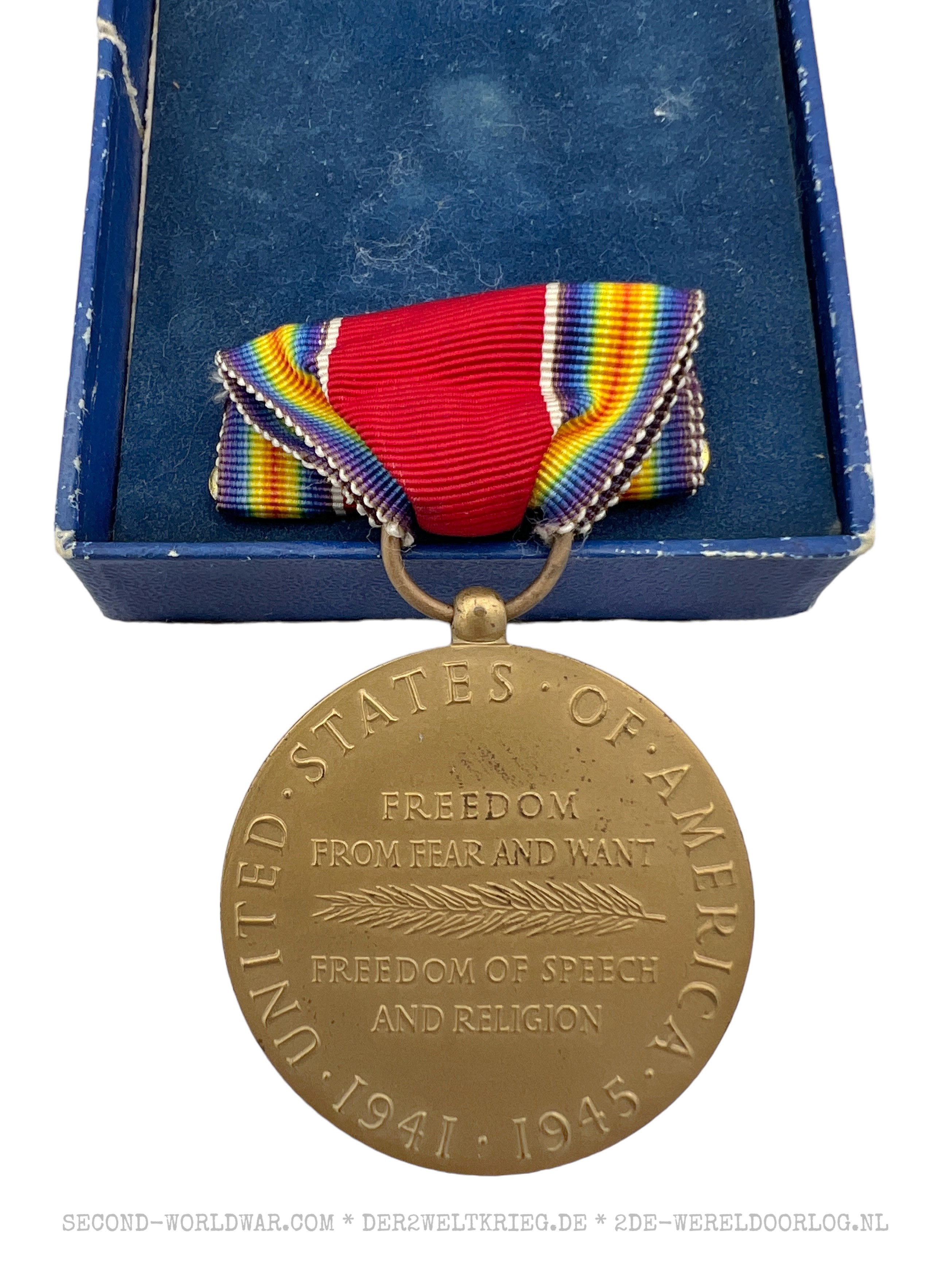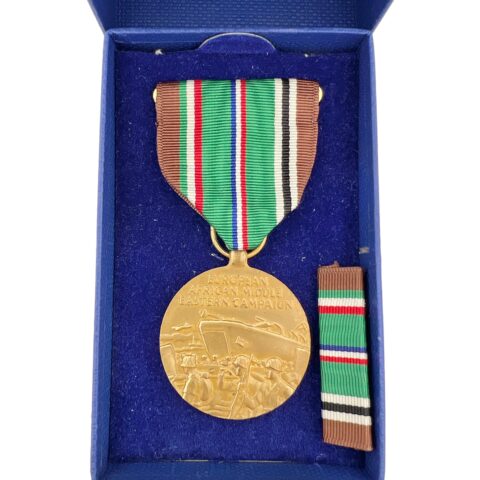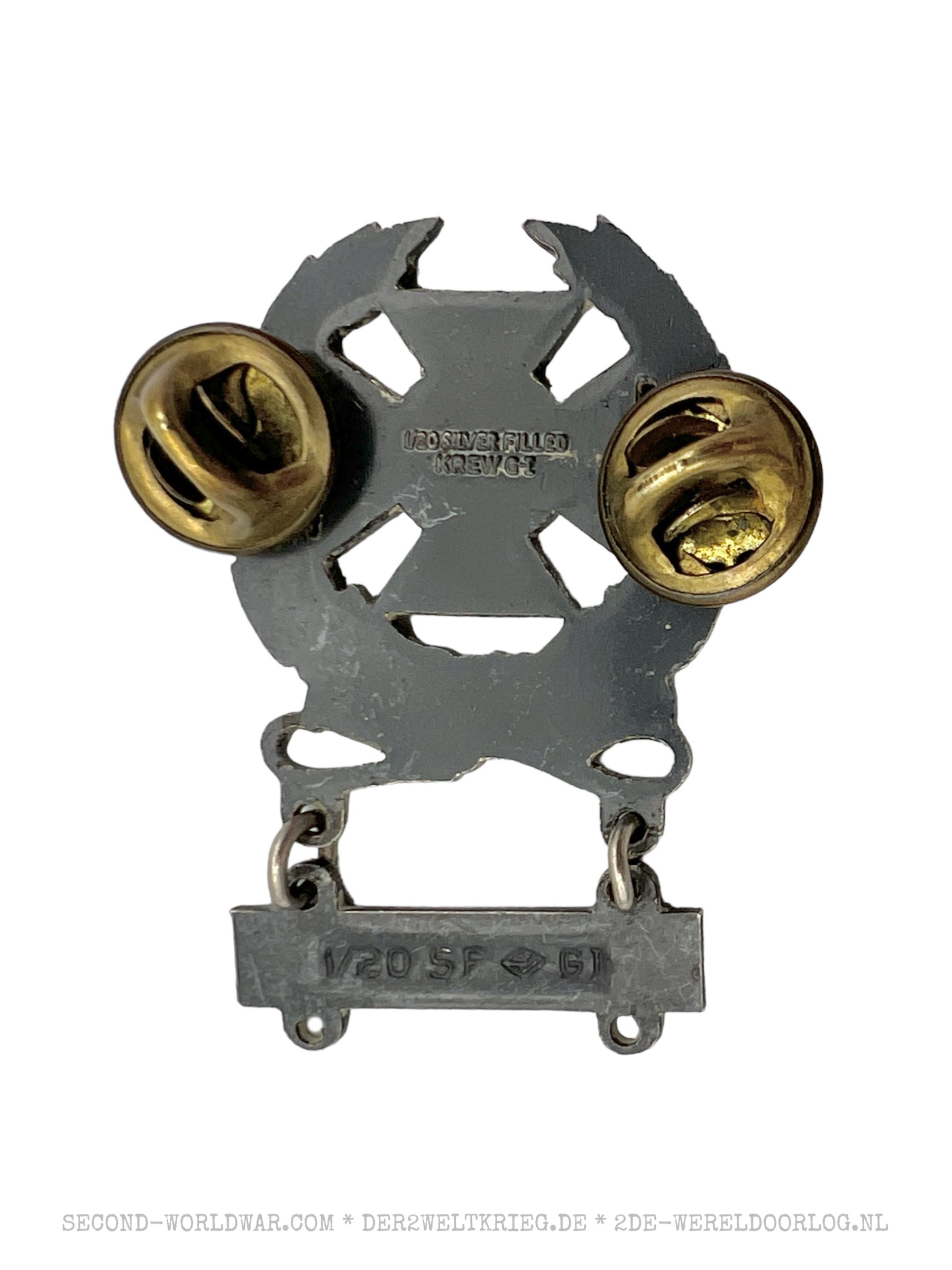American Defense Service medal, Good Conduct medal, Asiatic–Pacific Campaign medal with ribbon bar
€69,00
In stock
The American Defense Service Medal was a military award of the United States Armed Forces, established by Executive Order 8808, by President Franklin D. Roosevelt, on June 28, 1941.[1][2] The medal was intended to recognize those military service members who had served on active duty between September 8, 1939, and December 7, 1941.
A similar medal, known as the American Campaign Medal, was established in 1942, for service in the American Theater during the World War II era.
History
The American Defense Service Medal was established by Executive Order 8808, on 28 June 1941, by President Franklin D. Roosevelt and announced in War Department Bulletin 17, 1941. The criteria for the medal was announced in War Department Circular 44, on 13 February 1942. The service ribbon design was approved by the Secretary of War and the Secretary of the Navy on January 7, 1942. The medal was designed by Mr. Lee Lawrie, a civilian sculptor from Easton, Maryland. The model was approved by the Commission of Fine Arts on May 5, 1942.[2][3]
Criteria
The medal is authorized to military members who served on active duty between President Roosevelt's declaration of a limited national emergency on September 8, 1939, and the attack on Pearl Harbor on December 7, 1941. Members of the United States Army, to include those in the Organized Reserve and National Guard, received this medal for any length of service during the eligibility period, provided that they were on orders to active duty for a period of twelve months or longer.[1] The United States Navy excluded those reservists who were on active duty for less than ten days during the eligibility period, but otherwise the Navy, United States Marine Corps, and United States Coast Guard awarded the medal to all personnel who served on active duty at any time during the eligibility period, Regular or Reservist, provided they passed their initial physical examinations, such as in the case of those Reservists called back to extended active duty prior to the December 7, 1941, attack on Pearl Harbor, or enlisted recruits or officer candidates who entered the Navy or Marine Corps during the same period.[4]
Appearance

The bronze medal is 1+1⁄4 inches (32 mm) in diameter. On the obverse is a female Grecian figure symbolic of defense, holding in her sinister hand an ancient war shield in reverse and her dexter hand brandishing a sword above her head, and standing upon a conventionalized oak branch with four leaves. Around the top is the lettering "AMERICAN DEFENSE". The reverse is the wording "FOR SERVICE DURING THE LIMITED EMERGENCY PROCLAIMED BY THE PRESIDENT ON SEPTEMBER 8, 1939 OR DURING THE UNLIMITED EMERGENCY PROCLAIMED BY THE PRESIDENT ON MAY 27, 1941" above a seven-leafed spray of laurel.[2][3]
The suspension and service ribbon of the medal is 1+3⁄8 inches (35 mm) wide and consists of the following stripes: 3⁄16 in (4.8 mm) Golden Yellow 67104; 1⁄8 in (3.2 mm) triparted Old Glory Blue 67178; White 67101; and Scarlet 67111; center 3⁄4 in (19 mm) Golden Yellow; 1⁄8 in (3.2 mm) triparted Scarlet; White; and Old Glory Blue 67178; and 3⁄16 in (4.8 mm) Golden yellow. The golden yellow color was symbolic of the golden opportunity of the youth of the United States to serve the National colors, represented by the blue, white and red pin stripes on each side.[2][3]
Devices
The American Defense Service Medal was authorized with the following devices:
- Foreign Service Clasp: Issued by the United States Army for military service outside the continental limits of the United States, including service in Alaska. The foreign service clasp is a bronze bar 1⁄8 inch (3.2 mm) in width and 1+1⁄2 in (38 mm) in length with the words FOREIGN SERVICE, with a star at each end of the inscription.[1]
- Base Clasp: Issued by the U.S. Navy and United States Marine Corps for service outside the continental limits of the United States (service in either Alaska or Hawaii qualified).[4]
- Fleet Clasp: Issued by the Navy, Marine Corps and United States Coast Guard for service on the high seas while regularly attached to any vessels of the Atlantic, Pacific, or Asiatic fleets as well as vessels of the Naval Transport Service and vessels operating directly under the Chief of Naval Operations.[4] The Fleet clasp is a bronze bar 1⁄8 inch (3.2 mm) in width and 1+1⁄2 in (38 mm) in length with the words FLEET inscribed.
- Sea Clasp: Issued by the Coast Guard for all other vessels and aircraft, not qualifying for the Fleet Clasp, which regularly conducted patrols at sea.[4]
- "A" Device: Awarded to any member of the Navy who served duty in actual or potential belligerent contact with Axis Powers in the Atlantic Ocean between June 22 and December 7, 1941.[4] The "A" Device was also worn on the medal's uniform ribbon.
- Service star: Worn in lieu of clasps when wearing the American Defense Service Medal as a ribbon on a military uniform.[1][3][4]
See also
Bibliography
- Foster, Frank C. (2002). A complete guide to all United States military medals, 1939 to present. Fountain Inn, S.C.: MOA Press. ISBN 978-1-884-45218-5. OCLC 54755134.
- Kerrigan, Evans E. (1971). American war medals and decorations. New York: Viking Press. ISBN 978-0-670-12101-4. OCLC 128058.
- Kerrigan, Evans E. (1990). American medals and decorations. Noroton Heights, CT: Medallic. ISBN 978-0-792-45082-5. OCLC 21467942.
- Robles, Philip K. (1971). United States military medals and ribbons. Rutland, VT: C. E. Tuttle. ISBN 978-0-804-80048-8. OCLC 199721.
References
- ^ a b c d Army Regulation 600–8–22 Military Awards (PDF). Washington, DC: Headquarters Department of the Army. 24 June 2013. p. 70. Archived from the original (PDF) on 2017-04-10. Retrieved 2014-01-10.
- ^ a b c d "American Defense Service Medal". The Institute of Heraldry. Archived from the original on 2014-01-10. Retrieved 10 January 2014.
- ^ a b c d "American Defense Service Medal". Air Force Personnel Center. 2 August 2010. Archived from the original on 6 November 2013. Retrieved 10 January 2014.
- ^ a b c d e f Navy and Marine Corps Awards Manual (PDF). Washington, DC: Department of the Navy. 1953. pp. 57–59. NavPers 15,790. Archived from the original (PDF) on 2012-02-16. Retrieved 2014-01-10.
External links
External links
Media related to American Defense Service Medal at Wikimedia Commons
United States campaign, expeditionary, and service medals | |
|---|---|
| 1862–1906 | |
| 1905–1921 | |
| 1911–1941 | |
| 1936–1945 | |
| 1942–1949 | |
| 1953–1999 |
|
| 2003–present | |
The Good Conduct Medal is one of the oldest military awards of the United States Armed Forces. The U.S. Navy's variant of the Good Conduct Medal was established in 1869, the Marine Corps version in 1896, the Coast Guard version in 1923, the Army version in 1941, and the Air Force version in 1963; the Air Force Good Conduct Medal was temporarily discontinued from February 2006 to February 2009, followed by its subsequent reinstatement.
Criteria
The criteria for a Good Conduct Medal are defined by Executive Orders 8809, 9323, and 10444. The Good Conduct Medal, each one specific to one of the six branches of the U.S. Armed Forces, is currently awarded to any active duty enlisted member of the United States military who completes three consecutive years of "honorable and faithful service". Such service implies that a standard enlistment was completed without any non-judicial punishment, disciplinary infractions, or court martial offenses. If a service member commits an offense, the three-year mark "resets" and a service member must perform an additional three years of service without having to be disciplined, before the Good Conduct may be authorized.[1][2]
During times of war, the Good Conduct Medal may be awarded for one year of faithful service. The Good Conduct Medal may also be awarded posthumously, to any enlisted service member who dies in the line of duty.
Reserve components
Service for the Good Conduct Medal must be performed on active duty; with two exceptions, it is not awarded to enlisted members of the military reserve components, including the Army National Guard and Air National Guard, for inactive part-time (e.g., "drilling") reserve duty or full-time Army Reserve Technician or Air Reserve Technician (ART) status, although enlisted reservists and national guardsmen are eligible if they complete sufficient active service via mobilization to active duty. This restriction does not apply to full-time active duty enlisted members in the Reserve Component, such as Army and Air Force personnel in an Active Guard and Reserve (AGR) status, Navy personnel in a Full Time Support (FTS), previously known as Training & Administration of the Reserve (TAR), and Marine Corps Active Reserve (AR) programs.
On 1 January 2014, the Navy discontinued the Naval Reserve Meritorious Service Medal, a de facto Good Conduct Medal for Navy Reserve (formerly Naval Reserve) enlisted personnel. Since that date, all Navy enlisted personnel have received the Navy Good Conduct Medal, whether in a full-time active duty or a part-time drilling reserve status.[3]
The various services have established separate Reserve Good Conduct Medals, albeit under various names, as a comparable award available to enlisted Reserve and National Guard members who satisfactorily perform annual training, drill duty and any additional active duty of less than 3 consecutive years duration. The exception, as previously stated, is the United States Navy, which discontinued that service's separate award for Reserve Component enlisted personnel as of 1 January 2014.[3] Enlisted Navy Reservists now earn time towards the Navy Good Conduct Medal, the same as the Active Component (e.g., Regular Navy) and any time previously earned towards an unawarded Naval Reserve Meritorious Service Medal is automatically carried over to the Navy Good Conduct Medal.
Navy Good Conduct Medal

The Navy Good Conduct Medal is the oldest Good Conduct Medal, dating back to 26 April 1869. There have been a total of four versions of the Navy Good Conduct Medal, the first version of which was issued from 1870 to 1884. The original Navy Good Conduct Medal was also not worn on a uniform, but issued with discharge papers as a badge to present during reenlistment. A sailor in the Navy received a new Good Conduct Medal for each honorable enlistment completed.[5]
The second version of the Navy Good Conduct Medal was issued between 1880 and 1884. The medal was considered a "transitional decoration"[4] and was the first of the Good Conduct Medals to be worn on a uniform. The medal was phased out by 1885 and a new medal issued between 1885 and 1961. The new medal was a Good Conduct medallion suspended from an all-red ribbon. Enlistment bars, denoting each honorable enlistment completed, were pinned on the ribbon as attachments.
There was slight oddity during the Spanish–American War when the Navy created the Specially Meritorious Service Medal which also had an all-red suspension and service ribbon. There were recorded cases of Navy enlisted personnel who were awarded both the Good Conduct Medal and the Specially Meritorious Service Medal who wore two red service ribbons on their Navy service uniforms. This is one of the rare times in the history of U.S. military awards that two awards had identical ribbons.
In the 1950s bronze and silver 3/16-inch stars, with one silver star worn in lieu of five bronze stars (e.g., six awards), replaced the enlistment bars. Although the medal itself had not changed since 1884, in 1961 a ring suspension for the ribbon and medal combination was adopted, differentiating the suspension from its Marine Corps Good Conduct Medal counterpart and standardizing it with the majority of other service medals. It is this 1961 version of the Navy Good Conduct Medal that is still in use today.[6]
The current Navy Good Conduct Medal is issued to every active-duty enlisted sailor who completes three years of honorable and faithful service since 1 January 1996. For prior awards to personnel between 1 November 1963 and 1 January 1996, four years of service were required. The four-year requirement also applies for award of the Navy Good Conduct Medal from its original establishment until 1 November 1963.
Additional awards of the Navy Good Conduct Medal are denoted by bronze and silver 3/16-inch stars; silver stars are worn in place of five bronze ones.[7] The reverse side of the medal has three words, "FIDELITY ZEAL OBEDIENCE" superimposed in a semicircle. Upon 12 years of service, sailors are also allowed to wear gold-colored version of their petty officer insignia, something usually seen with those with the rate of chief petty officer or petty officer first class and above, but occasionally petty officer second class. Prior to June 2019, those 12 years had to be infraction-free. It is extremely rare in the contemporary U.S. Navy, but provisions do allow for sailors rated petty officer third class to wear gold rate insignia, provided they meet the same requirements.
-
Original Version
-
Transitional Version
-
Third Version
Marine Corps Good Conduct Medal

The Marine Corps Good Conduct Medal was established on 20 July 1896. The medal was originally a ribbon and medal suspended from a clasp bearing the words "U.S. Marine Corps". The clasp was eliminated after 1935 and the medal has remained unchanged in appearance since that time. Since its inception in 1896, the name of the recipient was engraved by hand on the reverse side of the medal until stamping the name on the medal began during World War II (numbered on the rim) and was done completely by 1951.[8]
Prior to 10 December 1945, four years of honorable creditable enlisted service was required in the Marine Corps for award of the Marine Corps Good Conduct Medal. After 10 December 1945, the required period of service was reduced to three years.[9] Since that latter date, members of the Marine Corps must have three consecutive years of honorable and faithful service in order to be eligible for the medal.
In 1953, the Marine Corps adopted bronze and silver 3/16-inch service stars to denote additional awards of the Good Conduct Medal, replacing enlistment bars showing each honorable period of service.
Coast Guard Good Conduct Medal
The Coast Guard Good Conduct Medal (CGGCM) was authorized by the Commandant of the Coast Guard on 18 May 1921, but not designed until 1923 and originally used enlistment bars as attachments, in the same manner as the Marine Corps and Navy Good Conduct Medals. In 1966, the Coast Guard began using bronze and silver 3/16-inch service stars to denote additional awards of the Coast Guard Good Conduct Medal.[10] Originally, the service requirement for the CGGCM was four continuous years of service. Starting on 1 July 1983, the service requirement was reduced to three years.[10]
Army Good Conduct Medal

The Army Good Conduct Medal was established by Executive Order 8809, dated 28 June 1941, and authorized the award for soldiers completing three years active service after that date.
The criteria were amended by Executive Order 9323, dated 31 March 1943, to authorize the award for enlisted soldiers having three years of service after 27 August 1940 or one year of service after 7 December 1941 while the United States is at war.
Executive Order 10444, dated 10 April 1953, revised the criteria to authorize the award for soldiers having three years of service after 27 August 1940; one year of service after 7 December 1941 while the United States is at war; and for soldiers having the first award for service after 27 June 1950 upon termination of service, for periods less than three years, but more than one year. An initial award of the Good Conduct Medal can also be awarded to soldiers with less than one year of service if the soldier was discharged due to an injury sustained in the line of duty or if died in service.
- The medal was designed by Mr. Joseph Kiselewski[11] and approved by the Secretary of War on 30 October 1942.
- The eagle, with wings spread, denotes vigilance and superiority.
- The horizontal sword denotes loyalty,
- The book represents knowledge acquired and ability gained.
- On the reverse, the lone star denotes merit.
- The wreath of laurel and oak leaves denotes reward and strength.
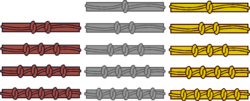
- The second and subsequent awards are indicated by the wear of the clasp with loops on the ribbon.
- Bronze clasps indicate the second (two loops) through fifth award (five loops);
- Silver clasps indicate sixth (one loop) through tenth award (five loops); and
- Gold clasps indicate eleventh (one loop) through the fifteenth award (five loops).
Officially, the Good Conduct Medal is awarded for exemplary behavior, efficiency, and fidelity in active Federal Military service. It is awarded on a selective basis to each soldier who distinguishes himself/herself from among his/her fellow soldiers by their exemplary conduct, efficiency, and fidelity throughout a specified period of continuous enlisted active Federal military service. Qualifying periods of service include each three years completed after 27 August 1940 or, for first award only, upon completion of at least one year upon termination of service if separated prior to three years. Also for the first award only, for those individuals who died before completing one year of active Federal military service if the death occurred in the line of duty. The immediate commander must approve the award and the award must be announced in permanent orders.[12]
The "loops" indicating subsequent awards were called "hitches", a "hitch" being three years of service. During the Vietnam War it was known as the "Dentyne wrapper" (chewing gum brand) owing to it being red and white like the medal's suspension ribbon.
Air Force Good Conduct Medal
The medal was authorized by Congress on 6 July 1960, but not created until 1 June 1963. Air Force personnel were issued the Army Good Conduct Medal between 1947 and 1963 and for those serving both before and after 1963, the Army and Air Force Good Conduct Medals could be worn simultaneously on an Air Force uniform.
The Air Force version is the same as the Army version, except that the suspension and service ribbons for the medals are different for each medal. The Air Force Good Conduct Medal has remained unchanged in appearance since its original design over fifty years ago. Additional awards of the Air Force Good Conduct Medal are denoted by bronze or silver oak leaf clusters.
The criteria for award of the Air Force Good Conduct medal are as follows: It is awarded to Air Force enlisted personnel during a three-year period of active military service or for a one-year period of service during a time of war. Those airmen who were awarded this medal must have had character and efficiency ratings of excellent or higher throughout the qualifying period including time spent in attendance at service schools, and there must have been no convictions of court martial or non-judicial punishment during this period.[13]
In October 2005, the 97th Air Force Uniform Board met and considered discontinuing the Good Conduct Medal with the rationale that good conduct of airmen is the expected standard, not an exceptional occurrence worthy of recognition. The decision was finalized on 8 February 2006 and the medal was no longer issued. Those airmen who had previously earned the Good Conduct Medal were still authorized to wear it. By May 2008, however, Air Force officials began reconsidering the policy.[14] On 11 February 2009, the medal was reinstated and made retroactive to 8 February 2006, with all eligible recipients being awarded the medal automatically.[15]
Space Force Good Conduct Medal
The Space Force has a Good Conduct Medal that was approved for wear as of September 25, 2023. Prior to this date, enlisted Space Force members were awarded the Air Force Good Conduct Medal. [16] [17]
See also
- Awards and decorations of the United States Army
- Awards and decorations of the United States Navy and Marine Corps
- Awards and decorations of the United States Air Force
- Awards and decorations of the United States Coast Guard
- Awards and decorations of the United States military
- Inter-service decorations of the United States military
- Coast and Geodetic Survey Good Conduct Medal
References
- ^ "Executive Order 8809 – Good Conduct Medal". Archives.gov. Retrieved 6 March 2013.
- ^ "Title 32 CFR 578.27". Gpo.gov. Retrieved 6 March 2013.
- ^ a b Mabus, Ray. "CHANGES TO NAVY GOOD CONDUCT MEDAL". ALNAV. US Navy. Retrieved 7 May 2014.
- ^ a b "Navy Good Conduct Medal". History.navy.mil. Archived from the original on 8 April 2010. Retrieved 30 October 2012.
- ^ "SECNAVINST 1650.1H 2006 4-3" (PDF). Doni.daps.dla. p. 115. Retrieved 30 October 2012.
- ^ "Archived copy" (PDF). Archived from the original (PDF) on 28 January 2017. Retrieved 6 September 2018.
{{cite web}}: CS1 maint: archived copy as title (link) - ^ Doug Sterner. "US Military Medals - Navy Good Conduct Medal". Homeofheroes.com. Retrieved 17 November 2016.
- ^ "The Evolution of the Good Conduct Medal". Naval History Blog. 26 April 2015. Retrieved 13 March 2019.
- ^ SECNAVINST 1650.1H NAVY AND MARINE CORPS AWARDS MANUAL. (PDF) . Retrieved on 2014-05-24.
- ^ a b "Coast Guard Military Medals and Awards Manual – COMDTINST M1650.25E" (PDF). USDHS / USCG. 15 August 2016. Retrieved 9 September 2018.
- ^ "1940s". Joseph Kiselewski. Retrieved 25 January 2024.
- ^ "Army Good Conduct Medal". Edocket.access.gpo.gov. Retrieved 30 October 2012.
- ^ "Factsheets : Air Force Good Conduct Medal". Afpc.af.mil. Archived from the original on 14 October 2012. Retrieved 30 October 2012.
- ^ "Good Conduct Medal poised for comeback – Air Force News | News from Afghanistan & Iraq". Air Force Times. Retrieved 30 October 2012.
- ^ Villagran, Paul (12 February 2009). "Air Force Good Conduct Medal reinstated". Af.mil/News.aspx. Secretary of the Air Force Public Affairs. Retrieved 24 June 2014.
- ^ "A Space Force Good Conduct Medal? Here's the Design Submitted for Approval". 4 February 2022.
- ^ "SECAF authorizes Space Force Good Conduct Medal". 25 February 2023.
External links
- Navy Good Conduct Medal Information at Naval Historical Center
- Good Conduct Medal award elimination explained, Air Force Print News
- Air Force Good Conduct Medal
- Army Human Resource Command Army Good Conduct Medal FAQ
- US Army Institute of Heraldry:Army Good Conduct Medal
| Decorations | |
|---|---|
| Unit awards | |
| Service medals | |
| Service ribbons | |
| Decorations | |
|---|---|
| Good conduct | |
| Unit awards | |
| Service ribbons | |
| Defunct | |
| Personal decorations | |
|---|---|
| Unit awards | |
| Good Conduct medals | |
| Expeditionary medals | |
| Service ribbon awards |
|
| Marksmanship | |

The Asiatic–Pacific Campaign Medal[1] is a United States military award of the Second World War, which was awarded to any member of the United States Armed Forces who served in the Asiatic-Pacific Theater from 1941 to 1945. The medal was created on November 6, 1942, by Executive Order 9265[2] issued by President Franklin D. Roosevelt. The medal was designed by Thomas Hudson Jones; the reverse side was designed by Adolph Alexander Weinman which is the same design as used on the reverse of the American Campaign Medal and European-African-Middle Eastern Campaign Medal.
There were 21 Army and 48 Navy-Marine Corps official campaigns of the Pacific Theater, denoted on the suspension and service ribbon of the medal by service stars which also were called "battle stars"; some Navy construction battalion units issued the medal with Arabic numerals. The Arrowhead device is authorized for those campaigns which involved participation in amphibious assault landings. The Fleet Marine Force Combat Operation Insignia is also authorized for wear on the medal for Navy service members who participated in combat while assigned to a Marine Corps unit. The flag colors of the United States and Japan are visible in the ribbon.
The Asiatic–Pacific Campaign Medal was first issued as a service ribbon in 1942. A full medal was authorized in 1947, the first of which was presented to General of the Army Douglas MacArthur. The European Theater equivalent of the medal was known as the European-African-Middle Eastern Campaign Medal.
Boundaries of Asiatic-Pacific Theater. (1) The eastern boundary is coincident with the western boundary of the American Theater. (2) The western boundary is from the North Pole south along the 60th meridian east longitude to its intersection with the east boundary of Iran, then south along the Iran boundary to the Gulf of Oman and the intersection of the 60th meridian east longitude, then south along the 60th meridian east longitude to the South Pole.[3]
US Army campaigns
The 16 officially recognized US Army campaigns in the Asiatic-Pacific Theater of Operations are:[4]
- Pacific Ocean Areas Command:
- Central Pacific: 7 December 1941 – 6 December 1943, allied landings on Tarawa and Makin during the Gilbert and Marshall Islands campaign
- Air Offensive Japan: 17 April 1942 – 2 September 1945
- Aleutian Islands: 3 June 1942 – 24 August 1943, the Aleutian Islands campaign
- Northern Solomons: 22 February 1943 – 21 November 1944, part of the Solomon Islands campaign
- Eastern Mandates: 31 January - 14 June 1944, allied landings on Kwajalein and Eniwetok during the Gilbert and Marshall Islands campaign
- Western Pacific: 15 June 1944 – 2 September 1945, the Mariana and Palau Islands campaign
- Ryukyus: 26 March - 2 July 1945, the allied landings on Okinawa
- South West Pacific Areas Command:
- Philippine Islands: 7 December 1941 – 10 May 1942, the Japanese conquest Philippines
- East Indies: 1 January - 22 July 1942, Japanese conquest of the Dutch East Indies
- Papua: 23 July 1942 – 23 January 1943, part of the New Guinea campaign
- Guadalcanal: 7 August 1942 – 21 February 1943, the Guadalcanal campaign
- New Guinea: 24 January 1943 – 31 December 1944, the New Guinea campaign
- Bismarck Archipelago: 15 December 1943 – 27 November 1944
- Leyte: 17 October 1944 – 1 July 1945, allied landings and liberation of Leyte
- Luzon: 15 December 1944 – 4 July 1945, allied landings and liberation of Luzon
- Southern Philippines: 27 February - 4 July 1945, allied liberation of the Southern Philippines during the Philippines campaign
US Navy - Marine Corps campaigns
The 43 officially recognized US Navy campaigns in the Pacific Theater of Operations are:[5]
- Pearl Harbor: Pearl Harbor-Midway: 7 December 1941
- Wake Island: 8–23 December 1941
- Philippine Islands operation: 8 December 1941 – 6 May 1942
- Netherlands East Indies engagements: 23 January – 27 February 1942
- Pacific raids (1942): 1 February – 10 March 1942
- Coral Sea: 4–8 May 1942
- Midway: 3–6 June 1942
- Guadalcanal-Tulagi landings: 7–9 August 1942 (First Savo)
- Capture and defense of Guadalcanal: 10 August 1942 – 8 February 1943
- Makin Raid: 17–18 August 1942
- Eastern Solomons: 23–25 August 1942
- Buin-Faisi-Tonolai raid: 5 October 1942
- Cape Esperance: 11–12 October 1942 (Second Savo)
- Santa Cruz Islands: 26 October 1942
- Guadalcanal: 12–15 November 1942 (Third Savo)
- Tassafaronga: 30 November – 1 December 1942 (Fourth Savo)
- Eastern New Guinea operation: 17 December 1942 – 24 July 1944
- Rennel Island: 29–30 January 1943
- Consolidation of Solomon Islands: 8 February 1943 – 15 March 1945
- Aleutians operation: 26 March – 2 June 1943
- New Georgia Group operation: 20 June – 16 October 1943
- Bismarck Archipelago operation: 25 June 1943 – 1 May 1944
- Pacific raids (1943): 31 August – 6 October 1943
- Treasury-Bougainville operation: 27 October – 15 December 1943
- Gilbert Islands operation: 13 November – 8 December 1943
- Marshall Islands operation: 26 November 1943 – 2 March 1944
- Asiatic-Pacific raids (1944): 16 February – 9 October 1944
- Western New Guinea operations: 21 April 1944 – 9 January 1945
- Marianas operation: 10 June – 27 August 1944
- Western Caroline Islands operation: 31 August – 14 October 1944
- Leyte operation: 10 October – 29 November 1944
- Luzon operation: 12 December 1944 – 1 April 1945
- Iwo Jima operation 15 February – 16 March 1945
- Okinawa Gunto operation: 17 March – 30 June 1945
- Third Fleet operations against Japan: 10 July – 15 August 1945
- Kurile Islands operation: 1 February 1944 – 11 August 1945
- Borneo operations: 27 April – 20 July 1945
- Tinian capture and occupation: 24 July – 1 August 1944
- Consolidation of the Southern Philippines: 28 February – 20 July 1945
- Hollandia operation: 21 April – 1 June 1944
- Manila Bay-Bicol operations: 29 January – 16 April 1945
- Escort, antisubmarine, armed guard and special operations: 7 December 1941 – 2 September 1945
- Submarine War Patrols (Pacific): 7 December 1941 – 2 September 1945
Other campaigns
For members of the U.S. military who did not receive campaign credit, but still served on active duty in the Pacific Theater, the following “blanket” campaigns are authorized for which the Asiatic–Pacific Campaign Medal is awarded without service stars.
- Antisubmarine December 7, 1941 – September 2, 1945
- Ground Combat: December 7, 1941 – September 2, 1945
- Air Combat: December 7, 1941 – September 2, 1945
See also
- Service Star
- Arrowhead device
- Awards and decorations of the United States military
- Coast and Geodetic Survey Pacific War Zone Medal
- Merchant Marine Pacific War Zone Medal
References
- ^ "Asiatic-Pacific Campaign Medal". edocket.access.gpo.gov. Retrieved 24 May 2023.
- ^ *Federal Register for Executive Order 9265
- ^ [1] Army Regulation 600–8–22
- ^ "Listing of the Campaigns of the U.S. Army". US Army Center of Military History. Retrieved 23 May 2020.
- ^ "World War II-Asiatic-Pacific Theater 1941-1946". Naval History and Heritage Command. Retrieved 10 June 2020.
External links
- Asiatic-Pacific Campaign Medal - Criteria, Background, and Images
- Navy Authorized Pacific Theater Engagements
- US Army TACOM, Clothing and Insignia PSID, Asiatic-Pacific Campaign Medal
United States campaign, expeditionary, and service medals | |
|---|---|
| 1862–1906 | |
| 1905–1921 | |
| 1911–1941 | |
| 1936–1945 | |
| 1942–1949 | |
| 1953–1999 |
|
| 2003–present | |
| Sculptures |
|
|---|---|
| Coins and medals |
|
| Related | |
Related products
-
American Cased Distinguished Flying Cross Medal with pin and ribbon
€219,00Original price was: €219,00.€179,00Current price is: €179,00.

